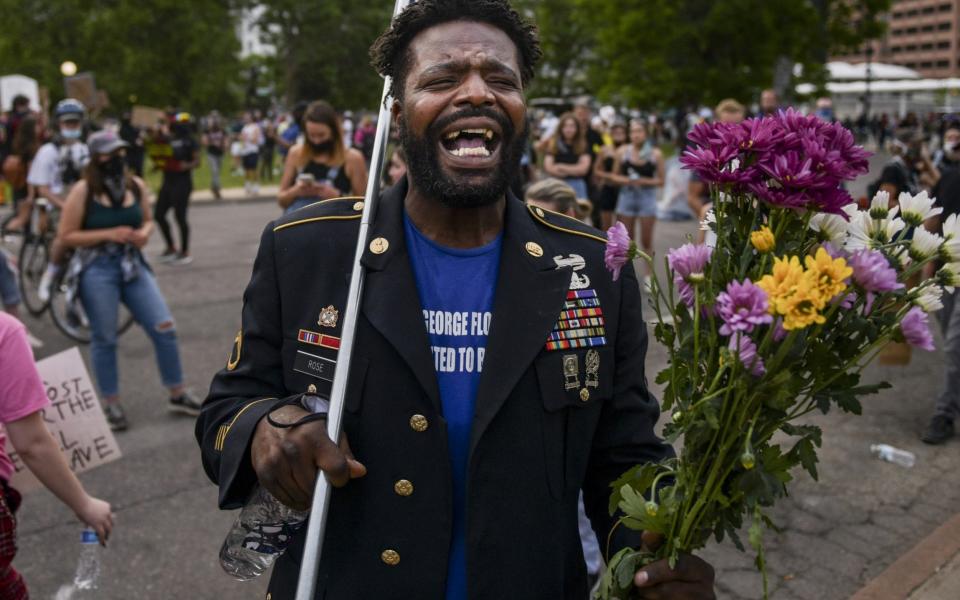George Floyd's place of death turns into makeshift shrine to peace

A large ring of flowers marks the spot where George Floyd met his end, gasping for breath as a white police officer pinned him down in the Southside neighbourhood of Minneapolis.
Since his death last week, the area has become a rallying point for a tight-knit community reeling from the death of yet another black man at the hands of the police.
Each day, hundreds of people make the pilgrimage along the blocked off streets leading to the Cup Foods corner shop where Mr Floyd was restrained, and ultimately killed, by officers.
Along the way, trestle tables have been laid out by locals offering free food, water and medicine to those affected by the looting that has swept through the city since the protests began.
A mural of Mr Floyd now adorns one wall of the Cup Foods building. The makeshift memorial is covered with "rest in power" signs and chalk messages left by the thousands of people who have come to pay their respects over the last seven days.

The violence that took place in this spot may have triggered the unrest that has flamed across the US this week, but the local community is determined to reclaim it as a peaceful area to honour Mr Floyd's memory.
It was here that Mr Floyd's younger brother, Terrence, called for an end to the violent clashes that have played out on America's TV screens.
“We’re sending a message to people all over this country to stop looting and throw up the peace sign,” he said during a visit to the area on Monday. “The power is in the numbers. Don’t stop protesting, but throw up the peace sign.”
Terrence said he did not want the scenes of fire and looting that have dominated the headlines to obscure the deeper meaning behind the protests.
“I’m not over here blowing up stuff,” he said, growing emotional. “What are y’all doing? You’re doing nothing. That’s not going to bring my brother back.”
Someone in the crowd shouted: “That’s not us.”
“Whoever’s doing it - relax,” Mr Floyd responded.
It is a sentiment that has been echoed in dozens of US cities, but has been lost in the face of increasingly aggressive encounters between a handful of police and protesters.
Behind the headlines of looting and destruction, countless examples of camaraderie between officers and demonstrators can be found.

In Long Beach, California members of the National Guard were photographed helping community members clean up the city on Monday following a night of unrest.
In Washington DC, protesters tackled a man to the ground as he hammered into the pavement to get hold of some bricks. The group later handed him over to police.
Protesters clutching megaphones in Detroit encouraged the crowds to go home and return the following day as the city's night time curfew approached.

Photographs in several cities show officers kneeling on the ground in solidarity with the protesters they have been sent to police.
Outside the Minnesota State Capitol building in St Paul, one officer was seen shedding tears as he kept watch over the large crowds that had gathered to chant "George Floyd, say his name!"
Back in Minneapolis' Southside neighbourhood, the tight-knit community has been eager to show the arson attacks and looting do not represent not the majority.
This Target store was one of the worst hit when the protests began pic.twitter.com/wNHHutDJxY
— Rozina Sabur (@RozinaSabur) May 30, 2020
They have turned out in their hundreds, armed with brooms and mops, to clear away the ash and graffiti covering local shops and restaurants.
One young protester, Kerian, told The Telegraph: "It's different to see it through a TV or phone so to kind of come and see is a whole different experience. This is a place of comfort, it's unified right now and just a place where you can feel safe and feel like everybody here loves you."
Will Robinson, a local artist and protest organiser, said the community has been working hard to identify and weed out the small handful who have been inciting violence.
"They are not part of these communities," he said Tuesday.
"The media is neglecting to cover this in the way it should be covered. They're claiming that the violence is being inflicted on our city by our own people and it's not true," he said. "Our main motive right now is to exude the image of peace."

